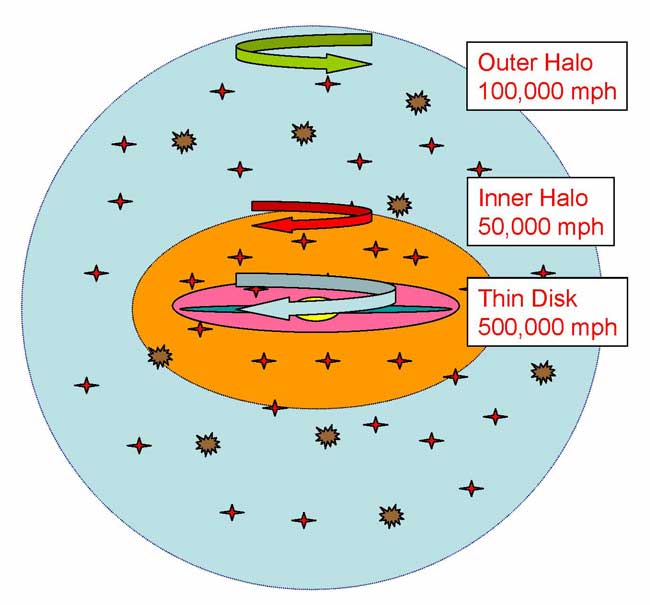Huge Newfound Part of Milky Way Rotates Backward

Our Milky Way Galaxy has two distinct parts in its outer reaches that rotate in opposite directions, astronomers announced today.
The galaxy has a bulbous core where stars are tightly packed and orbiting rather furiously around the central black hole. Then there's the big flat disk with its spiral arms, also orbiting the galactic center somewhat in the manner of a hurricane's spiral bands. We live on one of those arms. Around it all is a halo of stars that don't all behave in such an orderly fashion. That much researchers knew.
Now they find the halo has two parts.
"By examining the motions and chemical makeup of the stars, we can see that the inner and outer halos are quite different beasts and they probably formed in different ways at different times," said Daniela Carollo, a researcher at Italy's Torino Observatory and the Australian National University.
The finding, detailed in the Dec. 12 issue of the journal Nature, is based on 20,000 stars observed as part of the Sloan Digital Sky Survey.
The main galactic disk, home to our sun, rotates at an average speed of 500,000 mph. Surrounding the disk is what's now called the inner halo. It orbits in the same direction at about 50,000 mph. The outer halo, a sparsely populated region, spins in the opposite direction at roughly 100,000 mph.
There are chemical differences between the two parts, too. Stars in the inner halo have three times as many heavy atoms, including iron and calcium. These heavy elements were produced by massive stars that exploded fantastically and begat subsequent generations of stars.
Breaking space news, the latest updates on rocket launches, skywatching events and more!
"The halo is clearly divisible into two, broadly overlapping components,” said study team member Timothy C. Beers of Michigan State University. “The discovery gives us a much clearer picture of the formation of the first objects in our galaxy and in the entire universe.”
The study adds to other evidence showing the galaxy was not built in a cosmic day. Rather, it assembled over time, gobbling smaller galaxies in one of nature's greatest construction projects.
The inner halo probably formed first, from collisions between smaller galaxies that had been captured by the Milky Way's gravitation. The outer halo formed later, the thinking goes, as small galaxies (orbiting opposite our own) were lured in and torn apart.
"We still have a lot to understand," said Masashi Chiba of Japan's Tohoku University.
- The Strangest Things in Space
- Video: Our Corner of the Cosmos
- When Galaxies Collide

Rob has been producing internet content since the mid-1990s. He was a writer, editor and Director of Site Operations at Space.com starting in 1999. He served as Managing Editor of LiveScience since its launch in 2004. He then oversaw news operations for the Space.com's then-parent company TechMediaNetwork's growing suite of technology, science and business news sites. Prior to joining the company, Rob was an editor at The Star-Ledger in New Jersey. He has a journalism degree from Humboldt State University in California, is an author and also writes for Medium.
